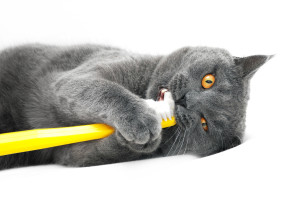Ask any cat owner about how they care for their feline’s teeth and most will reply that “he eats dry food” or, more commonly “I really don’t clean her teeth”. While most veterinarians will acknowledge that brushing a cat’s teeth is a challenge for many owners, they will stress the importance of routine oral assessment of your cat’s mouth. These exams help find preventable problems and even some very concerning issues. One of those concerns we are seeing more frequently is called Feline Tooth Resorption.
Tooth Resorption, or “TR” as it is commonly called, is a condition seen in a growing percentage of cats over the age of six years. The same strange condition is also seen in dogs and in people, but it is not nearly as common.
In the past, this disease has been called “neck lesions”, “cervical line lesions” and even the cumbersome “Feline Odontoclastic Resorptive Lesions (FORLs)”. Whatever the name, we know that this condition is seen in cats that often appear normal. The process will continue to develop, causing extreme pain because of the exposure of the root canal. This can even lead to behavior changes and lack of normal appetite.
The exact cause for TR has not been determined yet. Theories about exposure to certain viruses, breed prevalence, and chronic inflammation of the mouth and gums have all been proposed as root causes. There has been suggestion that high levels of Vitamin D in cat foods could be linked to resorptive disease, but that research is still ongoing. Interestingly, there has even been evidence of TR in cat skeletons that are 800 years old!
Clinically, most cats will appear normal, but observant owners may note that their cat prefers to chew food on just one side or that the cat stops grooming. They may “toss” dry food into the back of their mouth. As TR progresses, some pets will even develop sullen or aggressive attitudes, as if they are mad at the world!
Eventually, your veterinarian may point out how some of your cat’s cheek teeth are showing lines of inflamed, fleshy material right near the base of the tooth. At this point, the erosion has exposed the tooth to the bacteria of the mouth and this is when affected cats become extremely painful. Even under a general anesthetic, a slight touch of these teeth will cause a cat to “chatter” their jaw, indicating very serious pain!
Dental x-rays are the only way to diagnose TR. When the radiographs are taken, if TR is present, your veterinarian can see changes in the density of the roots and crowns of the teeth. All teeth can be affected, but the major “signal” tooth is the first one in the lower jaw. Some teeth can be partially affected, while others may have completely dissolved away leaving a “ghost image”.
Unfortunately, there is no effective treatment that can save the pet’s teeth. A normal cleaning and polishing will not work! Veterinary dentists have even tried root canal therapies (endodontics), but they fail, as this resorption occurs on a microscopic basis. A tooth that is showing any signs of resorption needs to be extracted. Some cats will need full mouth extractions. All cats with a known history of TR should be x-rayed every six months to a year. It is likely other teeth are affected and they must be monitored.
The good news in all of this is that once your veterinarian knows about the disease, several things can be done to keep your cat comfortable. Experience has shown that cats that were once not eating well or even aggressive will often have a positive behavior change in just a matter of weeks. It is surprising how the removal of these painful teeth can often bring back your affectionate feline friend.
Owners are often unaware that their pets are experiencing such discomfort. But, regular visits to your veterinarian can help identify the issue and start work that will make your cat feel better. Contact your veterinarian to have a comprehensive oral examination for your pet, including dental x-rays and regular dental cleanings.


